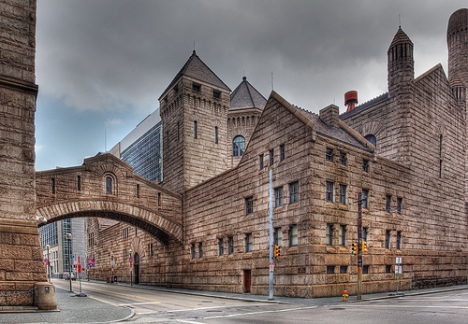What would a discussion be about a courthouse if the place where the convicted criminals went afterwards? The Allegheny County Jail complex, also designed by H. H. Richardson at the same time as the courthouse, is located just across Ross Street from the courthouse and now currently houses offices for judges and their staff. The jail has an interesting history, beginning with its design. Richardson designed the jail around the Auburn model. The Auburn model is a form of a prison system which enforces strict labor during the day and solitary confinement during the night. This was thought to allow “reflection on past deeds in silence.” (Link). The model, however, was quite outdated by the time Richardson began designing the jail. A new model, the Pennsylvania model, had become popular because it was more punishing for the prisoners and more efficient. Specifically, the Pennsylvania model kept prisoners in one cell all day long, seven days a week. Each cell had its own outdoor court and each prisoner never came into contact with another prisoner. This was the model Richardson chose to ignore in favor of the Auburn model.
As the picture above shows, the jail has four wings, each of which was comprised of cells. The inmates exercised and worked in the walled yard during day and slept in their solitary cells at night.
Aside from the design of the jail, a few noteworthy events occurred at the complex. An attempted murder on Henry Clay Frick occured during the Homestead Strike and the anarchist was held in the jail while he, Alexander Berkman, awaited trial. Berkman broke into the office of Frick during the Homestead Strike in 1892 where he shot Frick three times before being beat into unconsciousness. (Source)
Aside from the prisoners, the jail hosted an array of positive progressions in the field. Alice Ballard Montgomery, a juvenile probation officer, was the first to advocate for reform programs rather than punishment for juvenile inmates. Montgomery’s ideas were taken and now form the basis of reform in juvenile prisons around the country. However, not all great things last forever.
As Pittsburgh grew, so did its inmate population. The jail was not able to hold all the inmates the justice system was convicting. In addition, by the 1980’s the jail was becoming extremely outdated and was declared in 1990 to be unconstitutional. Construction began on a new complex and the new building opened in 1995 a few blocks down the road. After prisoners left the jail the interior was converted into office spaces and provided room for the Allegheny County Court of Common Pleas Family Division.
Overall, the jail has a similar design, with heavy stone and an overpowering nature, as the courthouse. The jail served Allegheny County well for the time it was in use, but, as the saying goes, all things must come to an end.



This is really interesting. I never put much thought into the design of a jail, and it is interesting to see how it would impact the prisoners. The noteworthy events include recognizable names, and that really helps to make a connection.
LikeLike